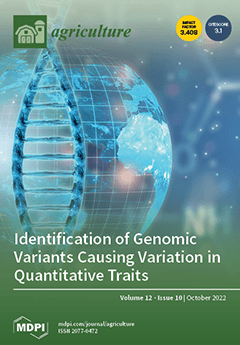No-till (NT) has been said to conserve soil moisture, maintain or increase organic matter (OM), and improve crop production compared to conventional tillage (CT). However, very few studies have explored the effect of these under dry-land agriculture with occasional tillage where ploughing is performed only after several years of NT, especially in KwaZulu–Natal. The aim of this study was to assess the effect of tillage and fertilizer application on selected physicochemical soil properties under rain-fed maize production. Soil samples from NT, conventional tillage in the 5th season (CT-Y5), and annual conventional tillage (CT-A) with 0, 60, 120, 240 kg N ha
−1 were taken at 0–10, 10–20, and 20–30 cm and analysed for pH, EC, exchangeable acidity, exchangeable bases, C:N, gravimetric water content, bulk density, and soil texture. Results showed that NT at 0 and 60 kg N ha
−1 in 0–10 cm had higher bases, gravimetric water content, pH, and EC compared CT-Y5 and CT-A (
p < 0.05). At 10–20 cm depth, CT-Y5 had higher gravimetric water content (0.17 gg
−1), followed by CT-A, (0.13 g g
−1), while NT had the least (0.11 g g
−1) (
p < 0.05) in the control treatment. Again at 20–30 cm depth, NT had higher (
p < 0.05) bases than CT-Y5 and CT-A tillage practices at 120 and 240 kg N ha
−1 application rate. Regression analysis of fertilizer application rate with both bases and gravimetric water content showed a strong relationship under NT. Better soil properties under both NT and CT-Y5 was attributed to residue cover and minimum disturbance of the soil, which encouraged infiltration, thus reducing runoff and evaporation from the soil surface. Accumulation of residue under conservation tillage enhances OM, which subsequently improves soil quality, whereas ploughing aerates the soil causing oxidation of OM, thus releasing H
+ ions. Again, fertilizer application induces mineralization of OM, thus, higher fertilizer application rates result in low levels of carbon. NT is well-recommended in conserving soil quality while sustaining crop productivity.
Full article





